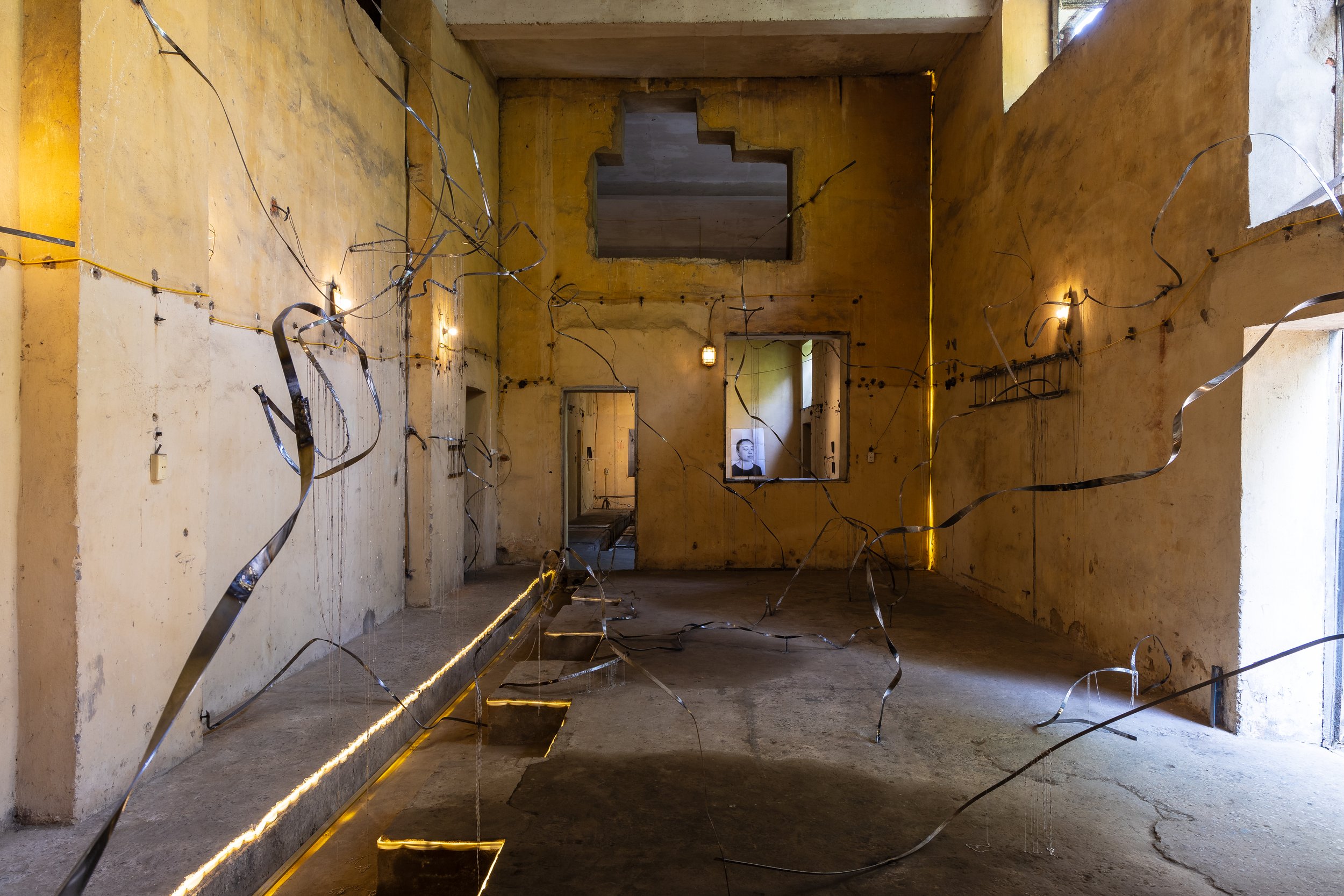Fresh Faces: Vy Trịnh
Sculpting the streets of Saigon
By Yu Ke Dong
A&M's Fresh Faces is where we profile an emerging artist from the region every month and speak to them about how they kick-started their career, how they continue to sustain their practice and what drives them as artists. Read our profile on Vy Trịnh here.
Portrait of Vy Trịnh. Photo courtesy of Natalie Suen.
In 2019, you graduated from Parsons School of Design with a BFA in Fine Arts, and subsequently attained a MFA in Fine Arts from the University of Pennsylvania in 2023. Tell us about these experiences.
Parsons was a transformative experience and I think of it fondly because of the people I have met and studied with. I am also fortunate to have been able to attend an art school in New York City – a dream I have had since I was a teenager. The city was an extended art school to me because I was exposed to many different art forms that I did not have access to in Vietnam.
At Parsons, I took my first sculpture classes and found out that I enjoyed working with my hands even though I did not focus solely on sculpture back then. I also learned a lot from my friends just by making works in proximity to each other. There was a lot of joy in making art, and the tinkering spark is something I have carried with me. Ultimately that is what matters; you have to enjoy it.
On a more personal level, Penn was pivotal because graduate school was when I decided to commit to sculpture. The experience was different from my undergraduate years because I studied art within a research university. I took classes in other departments such as anthropology and film, and the experience opened up the potential of art as a multi-disciplinary practice. It enabled me to absorb and integrate other ways of thinking and researching from different disciplines into my practice.
The works I made for my MFA also led up to my first solo show ‘On Da Dream’ (2024). During the first week of graduate school I already envisioned this all-sculpture show in my head, and I am glad I did not have to wait too long for it to happen.
My favorite MFA memories are live crit Bingo during final reviews, skating down the hall of Franklin the sculpture shop, and when we were randomly paired up and wrote about each other’s practice for thesis writing class. I did not pick my cohort, but those moments made me make sense of why we ended up together in the same year.
Who has been a mentor or an important artistic influence? And why?
Saigon, the city where I was born and grew up that has always been a crucial part of my life, later worked its way into my practice. It is the city that never rests. Traffic is always congested with honking mopeds, and sidewalks are packed with vendors and workers. I take cues from the ways in which everyday people inhabit these material processes from the street level. My making tendencies and methodologies emerge from and are conditioned by the fabric of the built environment.
I think these unique characteristics of the city inspire me to think through and with materiality, form, dimension, rhythm, and gravity. My experience growing up in this affective environment resulted in my artistic understanding of sculpture as not limited to “making”, but also “looking at and understanding the world sculpturally”, to quote Charles Ray.
‘On Da Dream’ would not have existed if I were born in a different city or country. My work emerges from the city, and it makes sense to show it in the city that gives it life.
What was one important piece of advice you were given?
I had this conversation with my mentor in graduate school and she told me to look from within and to learn more about myself. I thought it was generic and corny advice taken from self-help books at the time, but that has stayed with me, specially after ‘On Da Dream’ was realised and I made works that I did not think I would make. Through those works, I discovered parts of myself I had not considered before.
How did you arrive at sculpture as the main medium of your practice, and does sculpture as a medium provide any particular means of self-expression that other mediums do not allow?
At one point I realised that everything that I am interested in has led me to sculpture, even though I did not intentionally start with it. I love to sketch and draw, and I think of sculpture as a drawing in space. I also love reading about different spaces and looking at architectural drawings. Sculpture as a medium allows me to think through and with space, or even use space as a material. I think what is so unique about sculpture is it pushes and challenges me to work and think differently. The medium also teaches me a lot about working intuitively, which I think is the main factor that keeps pulling me in specific directions.
“I also love reading about different spaces and looking at architectural drawings. Sculpture as a medium allows me to think through and with space, or even use space as a material. ”
Architecture emerges as a key concern in your artistic practice, with several of your pieces engaging directly with the space in which it is installed. Your work for UNESCO’s Hanoi Festival of Creative Design in 2023, for instance, involved several expansive installations embedded within a high-voltage electric station in Hanoi. Are there any particular types of buildings or urban spaces that you are drawn to, and how do these spaces then translate into ideas for future pieces?
Too many to name, but one of my dream projects is to integrate sculpture into a children’s playground. A floating sculpture for a swimming pool would be cool too.
‘Overvoltage’, 2023, site-responsive intervention by Vy Trịnh, curated by Vân Đỗ, Gia Lâm Train Factory, Hanoi, Vietnam. Photo by Trieu Chien.
Last year, you concluded your solo exhibition ‘On Da Dream’ at Galerie Quynh. The exhibition showcased your extensive engagement with the streets of the city, with industrial and manufactured materials being a key element in many of your works. How did this opportunity come about and what drew you to the central themes of your exhibition?
I have known Galerie Quynh for a long time and had visited the gallery many times as a high school student. The curator of the show, Thái Hà, an alumna of the gallery, also happened to be my middle-school friend, and things just happened. We had dinner after many years of not seeing each other to catch-up and I showed her the works I had made in graduate school. I am grateful that I held my first solo exhibition there and I have received so much support from Quynh and Rob, the founders, the gallery staff and my amazing studio assistants. The designer of the show’s identity, Xuan, is also Thái Hà’s friend and long-term collaborator and we had great synergy amongst us working together. One of my favorite moments was when many people commented that the show felt like a labour of love, and it was. Many of my opportunities come from genuine friendships and that is what I hope for in my career moving forward: being able to work with friends who are genuine and great at what they do.
‘On Da Dream’, 2024, solo show by Vy Trịnh, curated by Thái Hà, Galerie Quynh, Ho Chi Minh City. Image courtesy of Galerie Quynh.
Could you share your favourite art space or gallery in the city where you currently reside? Why are you drawn to that space and what does it offer to you or your practice?
Galerie Quynh. Not only is it where I held my first solo exhibition, it is one of the most important spaces that supports many Vietnamese artists from different generations.
What are your hopes for your own local art scene, and regionally as well?
I hope to see the Vietnamese contemporary art scene continue to flourish and to reach a wider global audience.
EXPO CHICAGO 2025, solo show by Vy Trịnh presented by Galerie Quynh. Image courtesy of Galerie Quynh.
Are there any upcoming exhibitions/projects that you would like to share?
My first solo exhibition in the US, presented by Galerie Quynh, was recently on show at EXPO Chicago. The gallery will also show my recent works at ESTHER II in New York in early May.

















